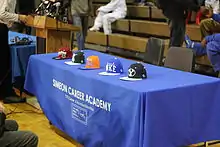National Letter of Intent
The National Letter of Intent (NLI) is a document used to indicate a student athlete's commitment to participating in National Collegiate Athletic Association (NCAA) colleges and universities in the United States. The NCAA Eligibility Center manages the daily operations of the NLI program while the Collegiate Commissioners Association (CCA) provides governance oversight of the program. Started in 1964 with seven conferences and eight independent institutions, the program now includes 676 Division I and II participating institutions. There are designated dates for different sports, and these dates are commonly referred to as "Signing Days".
Division III institutions are specifically banned from using the NLI, or any similar document that is not executed by non-athletes at those institutions.[1]
NLIs are typically faxed by the recruited student to the university's athletic department on a National Signing Day.[2] The NLI is a voluntary program with regard to both institutions and student-athletes. No prospective student-athlete or parent is required to sign the National Letter of Intent, and no institution is required to join the program.
History
J. William Davis, Professor of Government and Faculty Athletics Representative at Texas Technological College (now Texas Tech University), created the National Letter of Intent program in 1964. He was assisted by Howard Grubbs, who was Commissioner of the Southwest Conference at the time. It was not directly affiliated with the NCAA at the time of its creation and was created to protect both the university and student from either party backing out.[3] In October 2007, the NCAA became responsible for the administration of the program.[4]
NLIs and the recruiting process

National Letters of Intent may only be signed by prospective student-athletes who will be entering a four-year institution for the first time in the academic year after they sign the NLI.[5] Recruits who have signed NLIs must attend the schools they have signed with in order to receive financial aid, and NCAA rules forbid coaches from recruiting them further; these restrictions aim to add certainty to the recruiting process for players (who are certain to receive aid) and coaches (who are certain that a recruit will attend their school).[6] By contrast, oral commitments are nonbinding; recruits may change or revoke an oral commitment at any time, and coaches may continue to recruit an orally committed player.[7]
The restrictive nature of the NLI is designed to be advantageous to both prospective student-athletes and intercollegiate athletics programs. Intercollegiate athletics departments are not required to provide financial aid in cases where a student-athlete is not admitted for academic reasons. Seth Davis, a columnist for Sports Illustrated, has suggested that this arrangement is actually disadvantageous to student-athletes, as they have no recourse if an athletics department decides not to admit a player for non-academic reasons; for example, an athletics department could replace a signed recruit with another recruit by claiming that the first one was not admitted for academic reasons.[8]
Faxing of letters
Given the methods of transmitting NLIs that are available under NCAA rules, the letters are typically faxed by students to the university's athletic department.[2]
Although NCAA rules allow for use of postal mail, courier, and electronic transmission, nearly all students opt for fax machines, because of the speed of transmission and the ease of verifying signatures sent that way.[2]
College football
In NCAA Division I and II college football recruiting, there are two main recruit signing periods — early and regular.[3]
Added in 2017, college football has a short, three-day early signing period during the third week of December. Early signees have the opportunity to sign with their college team over a month before the regular signing period.[9] The first day of the early period is considered college football's first National Signing Day.
The regular signing period opens during the first week of February. The first day of this period is considered college football's second National Signing Day. The regular signing period closes on April 1 for NCAA Division I and on August 1 for NCAA Division II.[3]
See also
References
- "Bylaw 13.9.1 Letter-of-intent Prohibition" (PDF). 2018–19 NCAA Division III Manual. NCAA. p. 80. Retrieved January 28, 2019.
- Everson, Darren (February 2, 2011). "In College Football Recruiting, The Star Player Is the Fax Machine". Wall Street Journal. Retrieved February 2, 2011.
- "National Letter of Intent and National Signing Day". Next College Student Athlete. Retrieved January 29, 2022.
- History of the National Letter of Intent Program Archived 2008-03-13 at the Wayback Machine
- "National Letter of Intent: Text of the National Letter of Intent". Archived from the original on 2008-01-08. Retrieved 2007-12-31.
- "National Letter of Intent: Overview". Archived from the original on 2007-12-30. Retrieved 2007-12-31.
- "Inside the Verbal Commitment Circle". Retrieved 2007-12-31.
- "Seth Davis: For recruits, letters of intent are not the best option". CNN. 2007-11-14. Retrieved 2007-12-31.
- "The 6 biggest lessons of the Early Signing Period era". Banner Society. December 18, 2019.
External links
- National Letter of Intent website